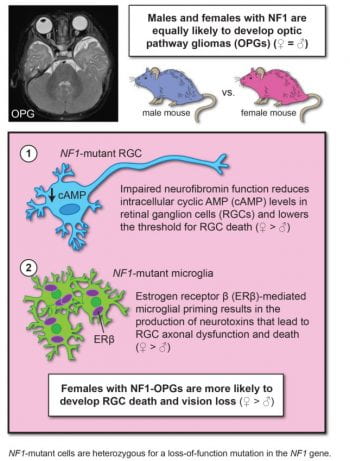
It has long been appreciated that the nervous system is distinct in males and females. These sexually dimorphic differences are relevant to NF1 brain tumors and autism. Whereas both girls and boys with NF1 develop optic gliomas, girls are 3 times more likely to experience visual decline from their tumors. In addition, autism is 3 times more common in boys in the general population, while in children with NF1 is only slightly more frequent in boys.
Using genetically engineered mice, we have begun to identify the cellular and molecular reasons that underlie these sexually dimorphic differences. In collaboration with Professor Helmut Kettenmann, we discovered that microglia respond to Nf1 mutation in other cells to drive male-specific defects in microglia function.
Additionally, we found greater neuronal damage in female mice with optic glioma, which results from estrogen regulation of immune system function. Relevant to vision loss secondary to optic glioma in children with NF1, Dr. Caroline Tang repurposed a drug currently being used to treat early onset puberty (Lupron) in children to reduce retinal ganglion cell damage in mice.
Current projects in the Gutmann research laboratory are focused on defining the molecular and cellular basis for sexual specific effects on NF1-associated optic glioma and autism.
Featured photo: National Center for Microscopy and Imaging Research